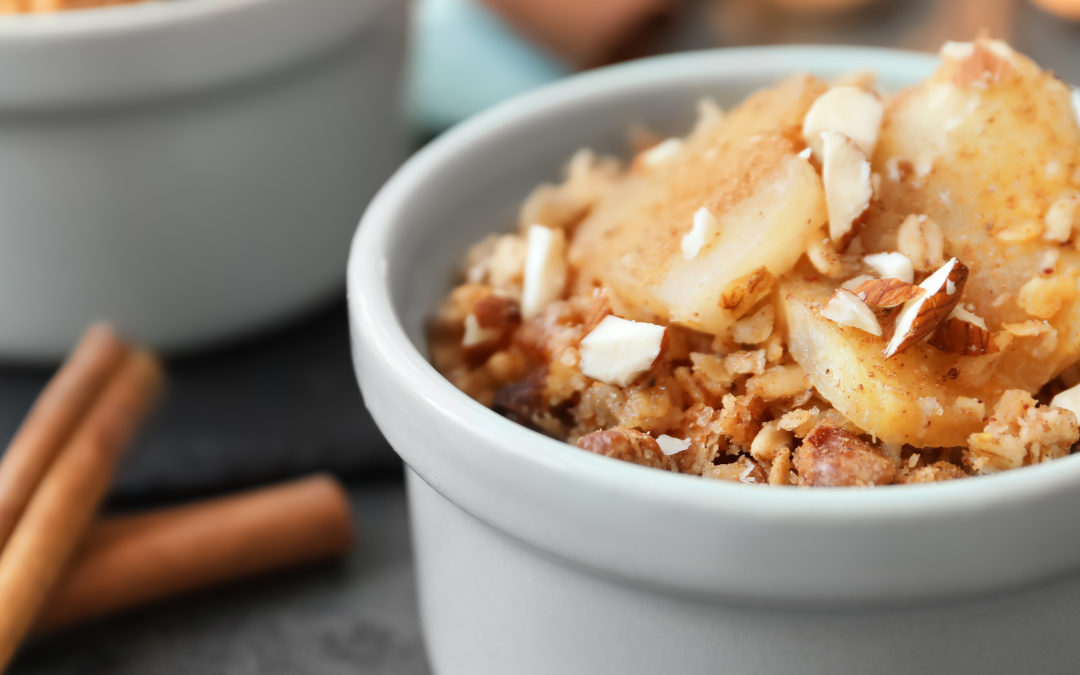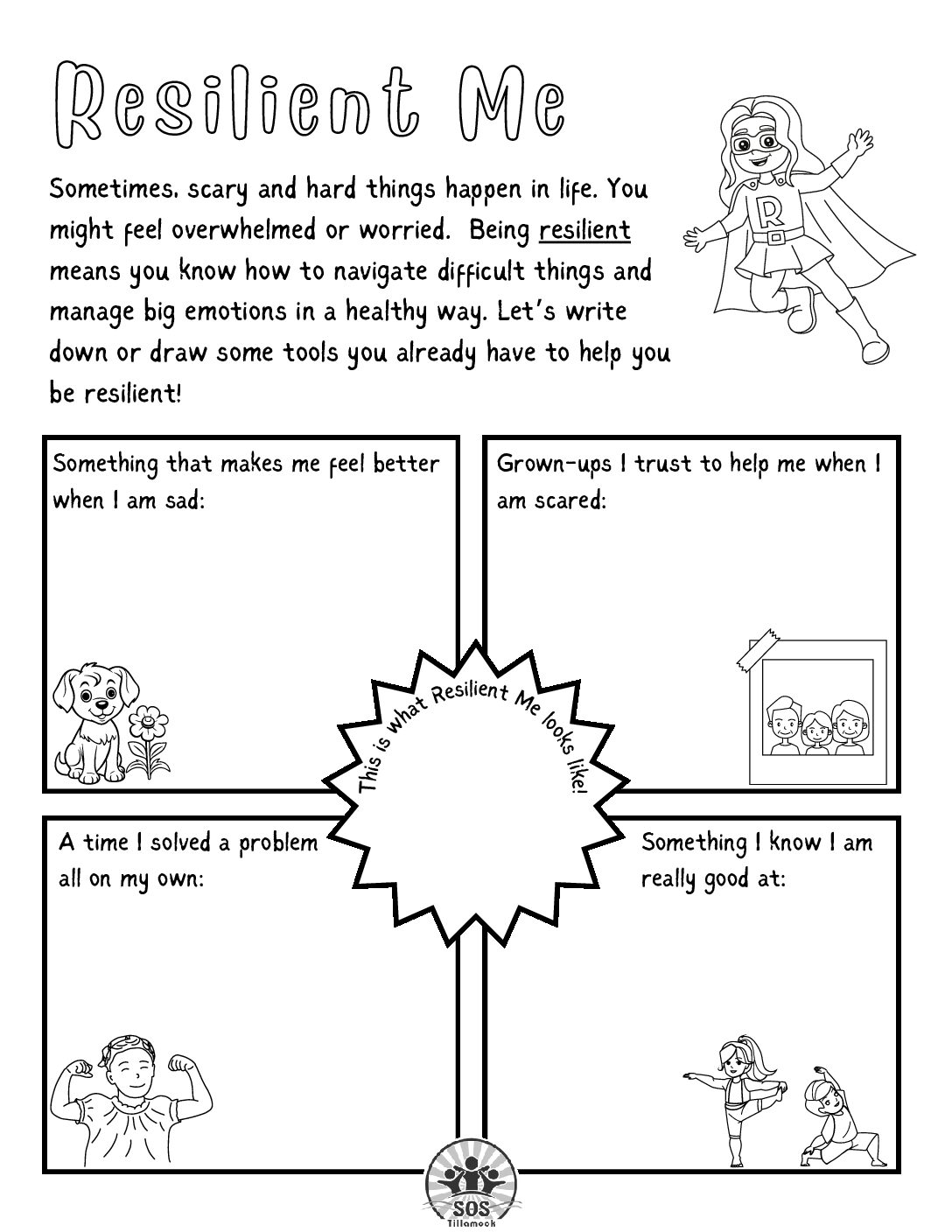
by Guest | Nov 15, 2024 | Eat Well, Featured, Lunch & Snack Recipes, Recipes
Ingredients
Butternut Apple Filling Ingredients:
1 small (about 1 pound) butternut squash
3 medium tart apples, sliced
2 Tablespoons lemon juice
½ cup packed brown sugar
1 Tablespoon corn starch
1 teaspoon ground cinnamon
½ teaspoon salt
Oat Topping Ingredients:
½ cup all-purpose flour
½ cup oats (old fashioned rolled or quick-cooking)
¼ cup packed brown sugar
¼ cup butter, melted
Directions
- Rinse or scrub fresh fruits and vegetables under running water before preparing.
- Heat oven to 375 degrees F. Lightly grease a 13×9-inch baking dish.
- Peel squash and cut in half lengthwise; discard seeds. Cut squash into thin slices.
- In a large bowl, stir together the filling ingredients until well mixed.
- Pour filling into baking dish. Cover and bake for 20 minutes.
- In a medium bowl, stir together brown sugar, flour and oats. Mix in the margarine or butter and set aside.
- Remove baking dish from oven and sprinkle topping over filling. Return uncovered dish to oven.
- Bake 25 minutes longer or until squash and apples are tender and topping is lightly browned. Serve warm.
- Refrigerate leftovers within 2 hours.

by Michelle | Nov 1, 2024 | Being Well, Featured, Move Well, Why I'm In
Why I’m “in” with Wellness
Michelle Jenck, Well-Being Director, Adventist Health Tillamook and Tillamook County Wellness Coordinator
Wishing for Wellness
I was recently asked how I came to be involved in wellness work. I’d like to say I was a lifelong fitness enthusiast but that isn’t true. As a child, I wanted to be physically fit and athletic but, alas, it was not in the cards for me. Severe asthma left me breathing into a brown paper bag on the sidelines and a debilitating eye condition called amblyopia, (my left eye is nearly blind), meant that, with no depth perception, I was to forever be, the “last one picked for the team.”
During middle school, I was too young to work, old enough to be home by myself but idle enough to have begun getting in trouble (serious, trouble). My saving grace was wandering into a YMCA to kill time after school. I started going to the weight room and pushing weights around. I had no idea what I was doing but kind people showed me what to do and what muscles I was working. It felt so good to feel a sense of control moving my body. I could push heavy things on purpose and muscles would form in places that were once squishy bits. It was like magic.
The best part was how weight training made me feel emotionally. I felt happier and gained a sense of control (something I have learned we need for good mental health, called a “locus of control.”) My self-esteem improved. I could set goals for myself and work to reach them, building successes I never believed possible for myself. I pursued weight training all through high school and was one of a few girls that joined the school’s newly formed competitive power lifting team.
My senior year in high school, I decided maybe I could push my body in other ways and began my first attempts at running. Initially, I “ran” 1-2 blocks and then sat on a curb breathing into a paper bag until my asthma attack subsided enough to slowly walk home. Tenacious and undaunted, I kept after my goal, gradually working my way up to running 2-3 miles at a time, and ultimately up to 6 miles over as many years. Running, even at a slow pace, helped me burn off stress and was a convenient way to get in a quick bout of exercise when I didn’t have time to hit the gym.
Working in Wellness
Through high school, college and into my young adult life, exercise was a staple. I tell people it should be like brushing your teeth; something you do every day without even thinking about it, because it is so ingrained in your routine.
As a stay-at-home mom, I was taking classes at the Tillamook YMCA, grateful to spend time among adults. One day, I made the fateful decision to ask Jeannie Christensen if there was ever going to be a step aerobics class offered at the Y. Like so many things in a small town, the answer was, “why don’t you start one?” Thus began a nearly 30-year career of teaching many different exercise disciplines.
I loved (and still love) teaching fitness classes. It is a way to give back, helping others experience their best life. Over all these years I have seen fitness change people from the inside out. That “locus of control,” it turns out, is an important component of life success and resilience. When we become aware of and gain control over moving our bodies, using our minds, it is very empowering.
The A-Ha Moment
By this time, our oldest son had been diagnosed with autism and our lives were changing dramatically. As we worked with our son to help him develop the ability to regulate his emotions and manage the sensory stimuli causing so much turmoil in his mind and body, I discovered magic could be found in movement. The most effective exercises involved movements that strengthened the parts of his brain involved in balance, spatial awareness and motor planning. How interesting, I thought. The same could be said for teaching a step class.
Teaching adults how to move, while helping our son re-wire his brain with movement, turned out to generate an “a-ha” moment of monumental proportions. As I began to understand how the brain is formed and how it changes with regular physical activity, I began to consider the larger implications of what I was learning. What could this mean for other children? For anyone who wanted to be more physically coordinated, better regulated, smarter and more successful?
Armed with this discovery, I decided to go back to school to pursue a Master of Education in Health & Kinesiology. Graduating in 2012, I used my degree to expand exercise programming at the YMCA, adding Tai Chi: Moving for Better Balance, which over 300 older adults took in 2014. The following year, I was tapped to help lead a community effort to focus on reducing chronic disease in Tillamook County, which led to the formation of Tillamook County Wellness.
My Hopes for Wellness
I am very grateful for my experiences and the opportunity to influence health at both the individual and population level. As I enter my ninth year as coordinator for Tillamook County Wellness, I am looking ahead; or better yet, I am looking further “upstream.” So much of what contributes to wellness can be found between our ears. The mind. The brain. The connection between the brain and the body. This is where wellness starts. And it starts early in life – in the womb, in fact. Nearly 90% of a child’s brain is developed by the age of three and much of that development depends on movement.
My hopes for wellness are that we will begin to prioritize proper movement, nutrition and secure relationships during this critical window of childhood development. Do I have ideas for this? You bet I do and I can’t wait to keep working on wellness!

by Guest | Oct 28, 2024 | Being Well, Featured, Uncategorized
…to taking action for breast cancer prevention and healing.
October is breast cancer awareness month. It’s also my birthday month, and I’m happy to say, I’ve come a long way in my healing as I now feel honored to share my birthday month with this awareness as many of us would like to not have to touch it with a 10 foot pole. You see, I’ve learned much about breast cancer from lived experience, both my own diagnosis and one of my sisters. My sister’s story ended with her dying from metastatic breast cancer only 2 years from her original diagnosis. I’m currently 2.5 years out and doing great as I plan to continue to do.
Neither of us were paying enough attention to our risk factors and we had several. There were many factors involved including earlier cancers and radiation treatments, environmental toxin exposures (we all live in a chemical soup world, reducing our exposures and supporting our body’s pathways of elimination are key) emotional and physical overwhelm/high stress, over-nurturing others and under-nurturing the self. Sound familiar anyone? 1 in 8 are the current statistical numbers of breast cancer occurrence among women. Also, did you know? 1 in 100 men are affected. Each story is unique and there are certain things that put each of us in different risk categories.
Knowing our risk factors, how many we have and what we can do to lower our risk factors with lifestyle modification are all within our control. I knew I was in a higher risk category from having had radiation therapy in my early 20’s. I knew I functioned at a high stress level, saw signs of estrogen dominance, was persistently overweight for many years, chronically inflamed and worked nights often as a birth doula plus a few other factors. Yet I just hoped eating organically and not exposing myself to more radiation would keep me healthy. It wasn’t enough. Receiving the diagnosis of invasive ductal carcinoma right after my sister’s passing was a doozy of a hit too, but through my lifestyle adaptions it has ultimately brought me back to my earlier life goal of longevity (living to 100 or beyond!) and living that life in vibrant wellness. Good health has always been a passion of mine, but it’s funny how we can let stress and certain situations lead us to believe we should accept less for ourselves. Ultimately cancer has taught me how to live well again. Thank goodness! However, it was not easy to go through to get myself back on track. I don’t actually recommend it 😉 It is therefore, my pleasure and task to share with others what they can do to ideally avoid diagnosis by steering away from known risk factors and incorporating lifestyle habits that decrease risk factors. I love sharing preventive habits and skills in general for us all (including prevention of other diseases too I’d like to add).
Know your risk factors. How many of these align with you?
Risk factors from CDC
- Being a woman
- Age: most diagnosed after 50
- Having BRCA1&2 genes (genetics can be dimmed or brightened with lifestyle)
- Reproductive history – beginning menstruation before age 12 and menopause after 50 – also – First baby after 30, no breast feeding, no full term pregnancy
- Having dense breast tissue/connective tissue (hard to read in mammograms and needs better lymph movement and movement in general) Ultrasound and thermography** are better at reading dense breast tissue **note that thermography isn’t currently utilized by conventional medicine.
- Having a personal history of breast cancer
- Other breast diseases such as atypical ductal hyperplasia, lobular carcinoma in situ
- Family history of breast or ovarian cancer (with or without BRCA gene) first degree relative; mom, sister, daughter – mother or father side
- Previous treatment with radiation (such as Hodgkins lymphoma also a sign the lymph system needs support)
- Exposure to DES drug – diethylstilbestrol – 1940-1971 – miscarriage prevention (mom and baby at higher risk)
- Not physically active
- Overweight or obesity after menopause
- HRT – hormone replacement therapy and slight increased risk seen from birth control pills.
- Drinking alcohol – risk increases with the more a woman drinks
- Smoking
- Night shift work
I would also add: environmental and food chemical additives that can overload our lymph and endocrine system as well as harm our gut microbiome.
Now to the empowering stuff!
What we can do: Taking action is key!
Eat more whole food plants! Eat more colors, eat seasonally, locally and clean/organic whenever possible. Check out the EWG’s list of clean 15 and dirty dozen to know what produce is ok to buy conventional/clean15 and which are ideal to buy organic/dirty dozen) Visit a local farm and enjoy their produce. They need our business through the cooler seasons too. Add one more vegetable to every meal and one new color a week. Ask about the farm’s growing habits. Find farms that don’t use chemicals. Many practice organic methods but don’t carry the certification yet and they’re happy to answer your inquiries.
Exercise! Move your body in ways that make you happy and feel good. Get moving every day. And this doesn’t mean stressed out running around, no, that’s counter productive. This means, enjoy a walk, hike or bike ride. Prioritize the time to commit to regular movement. You are so worth it! Walk one day, take a movement class another day such as Yoga or Joy Lymph Flow (a class I lead in Rockaway Beach and Nehalem) Tai Chi, Qigong or whatever you fancy, but it should bring ease to your body and time for repose. Turn on the music and dance! A fabulous way to heal many layers and promotes connection and health within the family if you live with others.
Quit smoking and don’t drink alcohol or limit your intake. Mocktails made with herbs are power packed with more phytonutrients that help us stay well and are an actual treat vs. a known risk factor.
Switch to natural household and personal care products. Don’t use anything with “fragrance” listed as an ingredient or chemical names you can’t pronounce or artificial colors. There are so many products out there, it can be overwhelming. Environmental Working Group also has a Skin Deep database listing products that are free from chemicals. It’s not one product that becomes the problem, it’s the many products together, it becomes a toxic load the body can’t handle. Switching to natural cleaners and personal care items actually uplifts our health instead.
Discuss your risk factors with your ND or MD and meet with a health coach like myself for support in making changes to your lifestyle at a pace that works for you to live a life that’s shown to be more preventive in lowering your risk factors and ideally avoiding this disease. I also teach breast massage for self-care and home screening. 3 This article is dedicated to those we’ve loved and let go of too early due to this disease and to those facing it now and in the future. May we all be free, live in flow, know ease and enjoy self care first so we may indeed be well and remain here for others.
Written by Elizabeth Golden Seaver, Health and Wellness Coach, Nehalem, OR and Tillamook County Wellness Coalition Member.
You can reach out to her at: goldenkeywellness.abmp.com, wingforwisdom@gmail.com
Other wellness questions? Email us at info@tillamookcountywellness.org. For more local health and wellness information, visit www.tillamookcountywellness.org or follow Tillamook County Wellness on Facebook and Instagram.

by Guest | Oct 18, 2024 | Eat Well, Featured, Lunch & Snack Recipes, Recipes
This festive combination of high-fiber whole wheat flour and canned pumpkin, creamy high-protein Greek yogurt, and a delicious medley of fall spices will give your little ghouls and goblins the energy they need for all their fun-filled Halloween activities! These pancakes are easy-to-make, wholesomely nutritious, and packed with your favorite flavors of the Fall season.
Ingredients:
- ¾ cup nonfat Greek yogurt
- ¾ cup milk
- 2 tablespoons butter plus additional for cooking the pancakes
- 1 ½ cups whole wheat flour
- 2 teaspoons baking powder
- ¾ teaspoon baking soda
- ½ teaspoon kosher salt
- ¾ teaspoons ground cinnamon
- ½ teaspoon ground ginger
- ⅛ teaspoon ground nutmeg
- ¾ cup pumpkin purée (not pumpkin pie filling)
- 2 large eggs
- 2 tablespoons pure maple syrup or honey
- 1 teaspoon pure vanilla extract
-
FOR SERVING (Optional):
- Pure maple syrup
- Butter
- Chopped toasted pecans
- Vanilla greek yogurt
Instructions:
In a medium bowl, whisk together the Greek yogurt and milk. Set aside and let rest for 5 minutes.
In a small bowl or saucepan, melt the butter. Set aside to cool.
In a large mixing bowl, whisk together the whole wheat flour, baking powder, baking soda, salt, cinnamon, ginger, and nutmeg until evenly combined.
To the bowl with the rested milk and yogurt, add the pumpkin puree, eggs, maple syrup, and vanilla. Whisk until well blended. Whisk in the melted, cooled butter.
Make a well in the center of the dry ingredients. Carefully pour in the wet ingredients. With a wooden spoon or rubber spatula, stir very gently, just until the flour disappears. The mixture will look lumpy. Let rest while the skillet preheats.
To cook: If you’d like to keep the pancakes warm between batches, preheat the oven to 200 degrees Fahrenheit and line a baking sheet with parchment paper. Preheat an electric griddle to 350 degrees F, or heat a large, nonstick skillet or cast iron skillet over medium low. Wait several minutes to allow the skillet fully preheat.
Melt a little butter on the skillet, or coat with nonstick spray. Scoop the batter into 1/4 cupfuls, leaving room for the pancakes to spread. Let cook on the first side until bubbles form on top and the edges of the pancakes look dry, about 4 minutes. Flip and cook on the other side, until the pancakes are golden and cooked through, about 2 to 3 minutes more. Adjust the heat as you go if the outsides begin to darken too quickly, before the insides are cooked through.
Repeat with remaining pancakes, adding more butter or nonstick spray to the skillet as needed and keeping the pancakes warm in the oven between batches as desired. Serve hot, with desired toppings.
Resource: https://www.wellplated.com/healthy-pumpkin-pancakes-recipe/

by Guest | Oct 11, 2024 | Being Well, Featured, Uncategorized, Work Well
Let’s face it: Whether you’re a single parent, have a supportive co-parent, or are part of a large, supportive family system, parenting well is hard. Kids, no matter how much we love them, don’t come with instruction manuals and often push us to our limits.
We want to bring our best selves to this parenting endeavor; we know how we treat and invest in our children will have lifelong repercussions . . . but sometimes we need a little support.
Engaging your child resourcefully, creatively, and educationally, boosting and encouraging playful curiosity, and celebrating developmental milestones—that’s what our family educators do every day. We believe that parents are their kids’ first and best teachers and we want to equip parents to engage their kiddos with creative, fun learning activities all year long.
Did you know that year-round support from Healthy Families and Early Head Start is available to families in every part of Tillamook County? Here’s what you need to know about our three Child & Family Programs, all housed under Community Action Team:
Healthy Families:
– Register your child within 90 days of birth
– Known for their diaper program
– Regular home visits, frequency of visits based on need
– Healthy Families – Community Action Team (cat-team.org)
Early Head Start:
– Registration accepted year-round, ages 0-3
– Weekly home visits
– Biweekly socializations/play dates
– Educational and literacy focus
– Seamless transition to Head Start (preschool, ages 3-5)
– www.nworheadstart.org
Head Start:
– preschool (drop off/pick up)
– only available to families living in Tillamook proper at this time
– 2 locations: 1100 Miller Ave, Tillamook, OR and 3808 12th Street, Tillamook, OR
– www.nworheadstart.org
We are a resource for you and want to make your parenting journey a little less
overwhelming, so you can offer your kiddo your very best self!
To reach out and ask questions, please contact:
Christina Pfister
Family Advocate for Early Head Start
971-813-9450
cpfister@nworheadstart.org
Written by Christina Pfister, Family Advocate for Early Head Start
Other wellness questions? Email us at info@tillamookcountywellness.org. For more local health and wellness information, visit www.tillamookcountywellness.org or follow Tillamook County Wellness on Facebook and Instagram.

by Guest | Oct 3, 2024 | Being Well, Featured, Uncategorized
Over the last few weeks, I have been reading a great book about addiction*. Preventing addiction is, after all, the core of my work as a Prevention Specialist. One line in particular stuck with me:
“The prevention of substance abuse needs to begin in the crib—and even before then, in the social recognition that nothing is more important for the future of our culture than the way children develop.”
Whether we are talking about addiction, mental health, or any number of other health outcomes, a child’s early development lays the groundwork for their future wellbeing. The notion that a child’s lifelong development is swayed by their earliest years can add a sense of urgency to days that are already strained in time and attention. The good news is that the conversations and daily interactions that parents have with their children are incredibly powerful in building resiliency, and that there are resources right here in Tillamook County to help parents explore what that means. But more on that at the end.
One side of the adolescent-substance-use-prevention coin is directly teaching kids about how alcohol and other drugs are harmful to their health. The Substance Abuse and Mental Health Services Administration’s (SAMHSA) “Talk. They Hear You.” campaign offers information for parents and caregivers on how and when to have conversations about alcohol and other drugs. Though it can feel like children don’t listen, the reality is that parents are among the strongest influences in their child’s decisions around substance use—they do hear you. Consider SAMHSA’s tips on age-appropriate conversations about substances:
- Under age 8: Explain the importance of good health and taking care of their bodies. If they take any vitamins or medications, explain that vitamins are to help them grow and medications are to help them be healthy. However, they should only take vitamins or medications that are given to them by a parent or caregiver, and taking someone else’s medicine could hurt them.
- Ages 8-12: Start asking open-ended questions, like what they have heard about alcohol or drugs. Let them know you are ready to talk if they ever have questions. Use “teachable moments”, like seeing alcohol or substances in movies, ads, or in stores, to explain that these substances are harmful to their bodies and health.
- Ages 13-16: Remember that many teens have peers or friends who may drink or use substances, so be ready to have direct conversations about what they have seen or experienced. Remind them that their brains are still developing until their mid-20s, and that avoiding substances is important to their health and growth. Clearly outline your family rules and expectations about underage substance use.
- Ages 17-20: Maintain clear rules that your child is never to use substances while they are underage or get into a car with a driver who has been drinking or using other drugs. Have conversations about adult responsibilities and decisions, and how they can continue to navigate substances and their health as they become an adult.
The other side of the adolescent-substance-use-prevention coin is, simply put, helping children build resiliency. The ability to manage stress and overcome challenges will serve children for their entire lives. This is certainly easier said than done. Many adults, myself included, struggle to consistently practice heathy ways of coping with stress. Fortunately, parents and caregivers in the Tillamook/Clatsop/Columbia region can take an Active Parenting class for free. This Active Parenting series will teach over 3 sessions: communication, problem-solving, discipline, family enrichment, and encouragement. Active Parenting provides an opportunity for parents to connect, while learning how to make the most out of those daily interactions and conversations with their children, how to pass on resilience, and how to focus on intentional, positive interactions and relationships with our children.
If you want to take advantage of the resources that are available to parents and caregivers, here is how you can find out more:
- “Talk. They Hear You.” webpage: samhsa.gov/talk-they-hear-you/parent-resources
- Active Parenting: The next Active Parenting series will be held on November 7, 14, and 21 from 6:00-7:45pm, via Zoom. To sign up, email MelissaCS@tfcc.org.**
- Parent and Caregiver Resource Workshop: An opportunity to connect with others to learn about and share information on resources available for parents, caregivers & children and why they matter. This workshop will be held on Tuesday, October 8 from 6:00-7:30pm, via Zoom. To sign up, email MelissaCS@tfcc.org.**
- “Resilient Me” is a coloring page for kids to help them identify the tools that they already have to help them be resilient. Download, print, and work through it together!
Be well, and happy fall!
* In the Realm of Hungry Ghosts– for any who are curious. Though first published 17 years ago, the content and propositions have largely stood the test of time.
**Mis is one of the amazing facilitators for Active Parenting, and is an invaluable resource for parenting education here in Tillamook County. Attending her sessions fills the soul!
Written by: Sarah Ermer, MPH, CHES; Prevention Specialist at Tillamook Family Counseling Center






